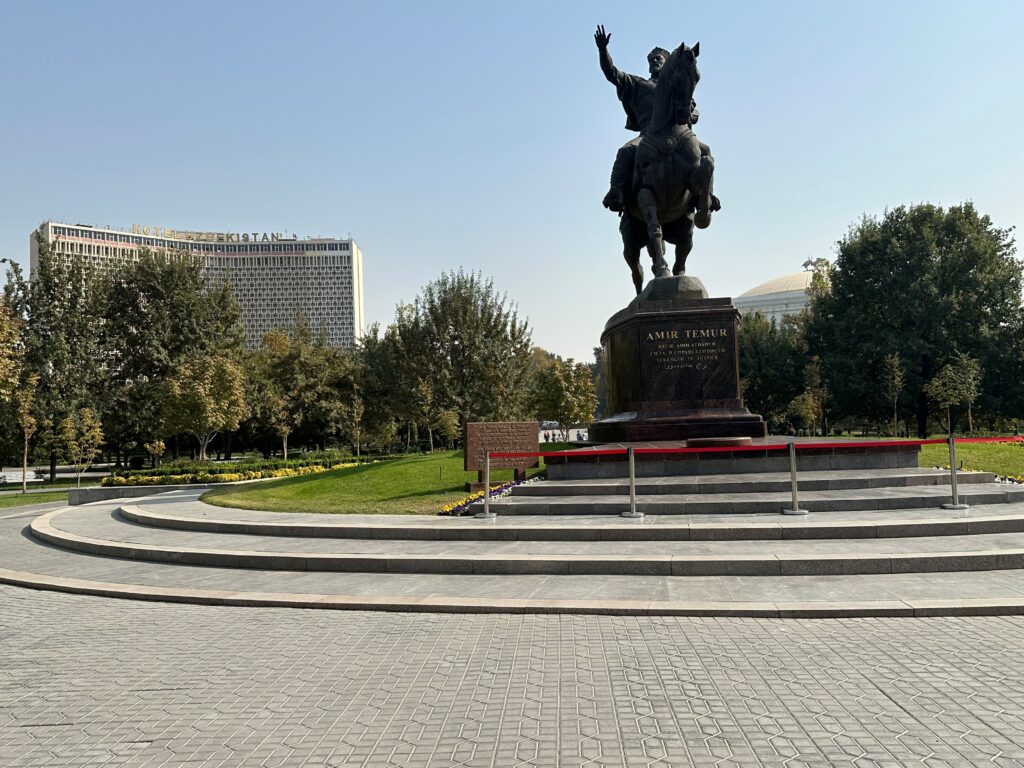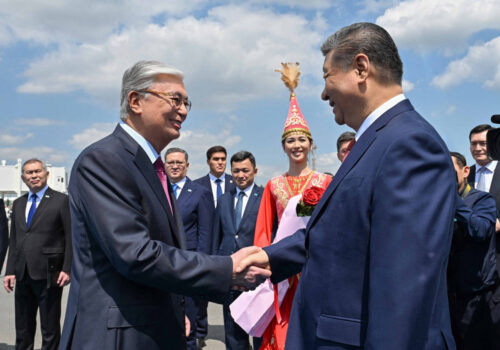FERGANA, Uzbekistan—In September 2022, deadly border clashes between Kyrgyzstan and Tajikistan threatened to open a new front of violence and instability in the Fergana Valley, the historic heart of Central Asia. But just three years later, the two countries signed a historic trilateral peace agreement with their neighbor Uzbekistan and now actively promote further government-to-government dialogue. Uzbekistan, whose leadership is also pursuing a suite of economic reforms, hopes that diplomacy and investment can usher in a new dawn to the once-restive Fergana Valley.
I traveled to Uzbekistan for the inaugural Fergana Peace Forum on October 15 and 16, which was billed as a platform to advance mutual understanding and provide an analytical framework for next steps in the peace process. The forum was convened by the Institute for Strategic and Regional Studies under the President of the Republic of Uzbekistan, the United Nations Regional Center for Preventative Diplomacy in Central Asia, the Organization for Security and Co-operation in Europe (OSCE), and other international partner organizations.
The governors of Uzbekistan, Kyrgyzstan, and Tajikistan’s respective border regions were at the forum, as were special representatives from the OSCE, European Union, various UN affiliates, and the Shanghai Cooperation Organization. The opening speeches were congratulatory and hopeful, if a bit staid in their guarded diplomatic language. In all, speakers and attendees alike seemed impressed that Kyrgyzstan, Tajikistan, and Uzbekistan had not only forged peace among themselves, but also agreed to come and engage in a relatively open setting. And rightly so, considering that only a few years ago, Kyrgyz and Tajik forces had been firing at each other just miles away.
The interesting discussion began when the principals departed and the state-affiliated think tankers metaphorically loosened their ties. An expert from one of the two countries that had been engaged in the border clashes expressed skepticism about the peace deal itself, noting that its details, including the borders, had not yet been made public. Across the two days of the forum, I saw Kyrgyz and some Tajik attendees speak quite openly with other foreign experts but not with each other.
Russia and China were ever-present topics of conversation, but their presence at the conference itself was relatively limited. True, China was the only non-Central Asian country to send a sitting diplomat to the forum (former Chinese Ambassador to Uzbekistan Sun Lijie), but no other Chinese experts attended. The one Russian speaker, a China expert from the state-connected Russian Academy of Sciences, railed against sanctions and the “weaponization of currencies,” a barely veiled reference to Western economic measures leveled against Moscow for its invasion of Ukraine. He quickly left the conference after his panel ended and declined to speak with other analysts, which seemed to annoy several of his Central Asian counterparts.
Washington’s role in the region also garnered interest at the conference, especially US President Donald Trump’s recent musings about reopening Bagram Airbase in nearby Afghanistan. Kyrgyz and Uzbek experts debated what Trump’s comments on Bagram meant but agreed that the US military reopening a base in the region would give them more leverage to resist security overtures from China and Russia, and it would thus be in their countries’ strategic interests. This was a remarkable statement: Four years after the bungled US exit from Kabul, Central Asian policy experts argued that a US return to Afghanistan might make the country’s neighbors more secure, not against the Taliban, but against Russian and Chinese overreach.
The forum’s second day was devoted almost entirely to local issues and the technocratic aspects of peacebuilding. Government officials laid out plans to solve water resource and transport issues, two of the main triggers of the 2022 violence. The Kyrgyz and Tajik think tankers I spoke with were not uniformly thrilled by the plans, citing continuing disagreements over transport routes and the terms of diplomatic engagement. It was a reminder of how fragile the peace process still is.
Young leaders of nongovernmental organizations from the three Fergana Valley countries, focused on everything from civic engagement to environmental protection to curbing domestic violence, deftly described why youth and independent civil society will be crucial to forging peace and more dynamic societies. That they were given the platform to express such views is a refreshing sign in a region often associated with heavy-handed governance and sclerotic administrative structures.
Following the forum, I traveled to Tashkent for meetings with government officials, financial sector analysts, and think tank leaders. Business appeared to be booming in the capital. Construction projects were everywhere—even in the unmistakably post-Soviet-looking city center—with plans for a new international exhibition center, new airport, and new neighborhoods all slated to be built in the next few years. The Ministry of Investment is working to prepare an initial public offering for a $1.7 billion vehicle of some state-owned enterprises, slated for early 2026 in either London or New York. The country’s first-ever “unicorn,” its national fintech champion Uzum, is not far behind. Last month, Uzbekistan agreed to purchase up to twenty-two passenger planes from Boeing in a deal worth up to eight billion dollars—another sign that it expects growth.
Uzbekistan is making big bets to modernize its fast-growing economy, which is projected to grow 6.8 percent this year. Strong economic growth will be important for providing better job prospects for its population of 37 million people, a majority of whom are under thirty years old. Several of the local experts I spoke with say the growth is being driven in part by the policies of President Shavkat Mirziyoyev, who initiated a push toward privatization and has empowered ministries to make investment deals with international firms. However, the state bureaucracy is vast and faces few incentives to change, so transparency and efficiency reforms may continue to face headwinds from entrenched interests. Bank privatization, for example, has slowed because bank executives are incentivized to maintain their stakes in state assets.
Uzbekistan has recently garnered renewed interest from the United States due to its abundance of critical minerals and rare-earth elements, which are crucial components for batteries, semiconductors, and advanced defense systems. The United States and Uzbekistan signed a critical minerals cooperation deal in April, and in September US mining investor Cove Capital agreed to open geological exploration projects.
Speed is critical. Think tankers and economic analysts who I spoke to in Tashkent repeatedly asked that US companies move their critical minerals projects faster, lest Chinese firms scoop up all the licenses for the best sites. Unlike the Chinese Communist Party, of course, the Trump administration cannot direct firms to make specific deals, but it does appear that Washington could be missing an opportunity by not acting faster in Central Asia. The Commerce Department and Development Finance Corporation are aware of these challenges and should be given the political latitude, resources, and staff to help make it possible for US companies to invest in the region by providing loan guarantees and equity financing, as well as by working to ensure a level business playing field for US firms.
The advances toward peace in the Fergana Valley and Uzbekistan’s economic growth are positive signs for security and prosperity in Central Asia. With a bit more effort and engagement, the United States could become a constructive partner in the region and reap mutual strategic and economic benefits.
Andrew D’Anieri is associate director of the Atlantic Council’s Eurasia Center. Find him on Twitter at @andrew_danieri.
The author’s trip to Fergana was supported by the Institute for Strategic and Regional Studies under the President of the Republic of Uzbekistan.
Further reading
Tue, Oct 21, 2025
How the US should partner with Central Asian states to avoid Russia-China dominance
New Atlanticist By Tatiana Gfoeller
By acting now, Washington can capitalize on the desire among some Central Asian states to reduce their dependence on Moscow and Beijing.
Fri, Aug 15, 2025
What Russia’s war on Ukraine means for Central Asia
New Atlanticist By Tatiana Gfoeller
The course of Russia’s war against Ukraine will have massive implications for Moscow and Beijing’s competition for influence in Central Asia.
Mon, Jun 9, 2025
Turkmenistan’s deepening water crisis could have far-reaching regional consequences
New Atlanticist By
Turkmenistan’s water crisis could have significant economic and political ramifications well beyond its borders.
Image: A photo of central Tashkent, Uzbekistan, taken in October, 2025. Andrew D'Anieri.




